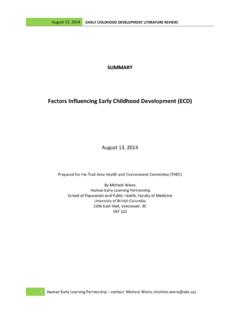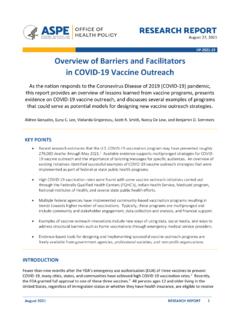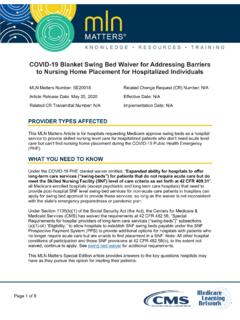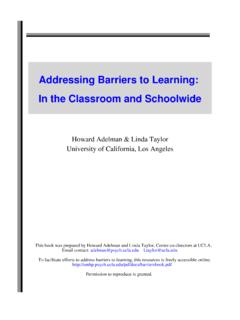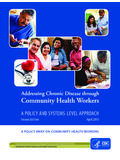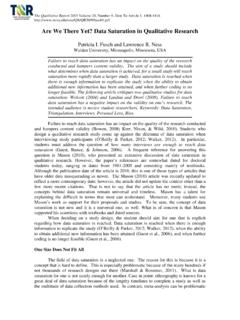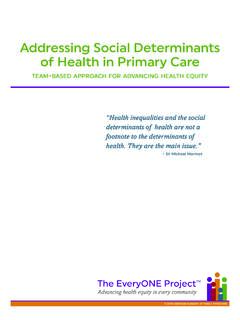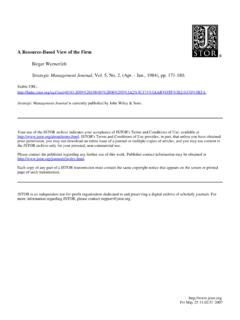Transcription of Addressing Barriers to Access - Human Early Learning ...
1 Fact sheet | aug 2011 Addressing Barriers to Access Children must get the best possible start in life. Their survival, protection, growth, and development in good health and with proper nutrition is the essential foundation of Human development. A World Fit For Children, UNICEF, 2008 There is much evidence that current family policies are not effective and that all is not well for young children and families in Canada1: Child vulnerability is too high (30%) and increasing; Income inequality is increasing and is leading to inequity in child outcomes; Incomes for young couples with children have stagnated since the 1970 s, even though more women are working and the cost of living has increased dramatically; and Programs and services are not able to cope with demand. For example, families can currently wait up to two years for an infant child care space in Vancouver and a similar gap between demand and supply is replicated across the province.
2 A world fit for children in which sustainable Human development, taking into account the best interests of the child, is founded on principles of democracy, equality, non-discrimination, peace and social justice and the universality, indivisibility, interdependence and interrelatedness of all Human rights, including the right to development. A World Fit For Children, UNICEF, 2008 Research Brief | 2012 Within the Convention on the Rights of the Child, General Comment No. 7 (GC7) provides particular guidance on implementing rights in Early childhood. GC7 acknowledges that the Early years place intense responsibilities on parents, requiring governments to develop an integrated approach to supporting families with policies that promote adequate parental time and resources to care personally for their young children ( appropriate taxation, benefits, housing, and working hours) along with a range of services that support young children s health, care, and education.
3 GC7 provides a framework for us to understand how we provide fully accessible services to all children, irrespective of income, ethnicity, or religion. It is therefore also an important backdrop to the focus of this paper - a discussion of Barriers to accessing services and ensuring inclusion for quality Early childhood services not only promote a young child s health, Learning , and skill development, but also positively influence their longer-term health, educational, and social outcomes2. This is particularly so for vulnerable children. Our challenge is to build services that reach all children and families, particularly those who need them PROPORTIONATELY UNIVERSAL SYSTEMIn our Research Brief on Proportionate Universality, we established the need to build a universal platform of services for all young children.
4 Within such a system, services may need to be provided at various levels of intensity and scale, tailored to the unique needs of certain populations and communities. Realizing a universal system that is locally responsive requires a partnership between governments (federal, provincial, and municipal) and community stakeholders. Governments need to increase public investment and create policy frameworks that support parents to care for their children through adequate, time, resources and services. While working to advance the required public policy and funding at senior levels of government, there is much that can be done at the same time locally to improve service delivery and planning, particularly through applying community knowledge to meet the needs of a community s most marginalized children and SERVICES IN COMMUNITYIt is important first to describe what we mean by a fully accessible service system, one that is built on the principle of universality but with specific provisions made for those who face particular Barriers to fully accessible service system Find ways to ensure complete Access to high quality services that address the specific needs of children and their families, in any community, particularly those who are more vulnerable and/or marginalized.
5 Take an holistic approach that stresses collaborative planning and service integration across traditional boundaries of child care, education, health, and social services; and Achieve the active involvement of all institutions and organizations in a community service providers, practitioners, parents, and community leaders from all sectors. Proportionate Universality: Universal programs at a scale and intensity that addresses quality, Access , and relationships at every level..A tiered system (..) designed to strengthen the capacity of the universal services to be truly inclusive and to cater more effectively to the diverse needs of all children and families. 3 What is a Barrier ? ..a perceived or real obstacle that makes it hard for a family and child to Access a program or services. A FRAMEWORK FOR UNDERSTANDING SERVICE BARRIERSOver twelve years of working with community service providers has allowed HELP researchers to identify a number of specific service Barriers that occur most commonly for families.
6 These include a shortage of available and/or affordable services; varying levels of parental knowledge and understanding of the importance of Early child development; work-life and time conflicts that make it hard to Access services/programs at the times they are offered; transportation constraints; language Barriers and a lack of environments that are welcoming for all. Service Barriers are about concrete issues such as a lack of affordability; but they are also about people needing services that are welcoming and safe. HELP has categorized local Barriers into infrastructure Barriers and those that are relational or Barriers 5 Program or Service is Not Available: This could mean that a service does not exist at all in a community or that existing services are : Affordability of child care programs is an issue not only for low income families but across the income spectrum.
7 Having children in child care is now often more expensive than paying university : Getting to and from programs, particularly for families without their own transportation, is often difficult. Having an easy and affordable way to travel to programs is critical. This can be complicated further in remote and rural locations where winter conditions make walking with children and strollers nearly and Delivery Integrated PolicyAdequate ResourcesSenior GovernmentsLocal GovernanceFIG 1: WHERE DOES RESPONSIBILITY LIE? Barriers TO SERVICE Access ARE REAL AND SIGNIFICANTOne of the greatest impediments to realizing a fully accessible service system for families with young children is the existence of Barriers to Access within and around existing services. Barriers prevent some children and families from accessing programs and services.
8 They tend to have a stronger influence among populations that have traditionally been less able to use existing services available, for a wide variety of reasons. They impact more significantly in low income neighbourhoods; certain cultural and immigrant groups; rural and remote areas; and non-traditional family structures. This is important because these groups tend to face more challenges and be less able to get the supports they need in a child s Early IMPORTANCE OF QUALITYThis brief focuses on the issue of Barriers to service Access . At the same time, it is important to remember that a core component of an effective service system, one that optimizes child development outcomes, is service quality. Research has clearly demonstrated that low quality services do not lead to improved child development.
9 It is only when families with young children have full Access to services that are of high quality that we see a significant improvement in FIG 2: UNDERSTANDING BARRIERSFIG 1: WHERE DOES RESPONSIBILITY LIE?TAKING ACTION TO REDUCE BARRIERSB arriers to Access experienced by children and families exist in a broader context of service Barriers that cannot be addressed at a local level but require policy and funding attention from senior governments in order to substantially and broadly increase Access . For example, the significant shortage of quality, affordable child care spaces throughout most of Canada, outside of these constraints, there is potential to address Barriers to Access at the community level. For example, local service providers can collaborate to ensure that their family drop-in programs are scheduled to maximize parental attendance.
10 HELP has begun to identify some characteristics of community action that are making a difference for children and families. These learnings can inform efforts to reduce Barriers in your community. Increasing public awareness of the importance of Early years services for all children is an important first step towards increasing public support for improved service Access . Increasing public awareness of the existing Barriers to Access many communities have documented and shared the current reality, highlighting the unmet demand for child care spaces, affordable parent fees, and waitlists for services for children with additional support needs, etc. This is important information to inform both local planning and strategies to influence public policy. Intersectoral collaboration matters. Any plan to improve accessibility has to include all of the agencies and ministries that serve children.


